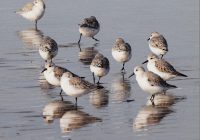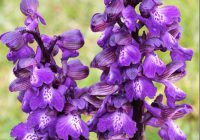Dr Phil Smith’s Wildlife Notes
April 2017
Since I started these notes in 2007, almost every April has been characterised by prolonged drought conditions. However, with a total of about 5mm of rain falling on five days during the month, this has been arguably the worst yet. The Met. Office acknowledged that April 2017 was the 10th driest on record for the UK but most other parts of the country had far more rain than us. Climate scientists have shown that spring droughts here are linked to persistent high-pressure systems over Greenland. These interfere with the North Atlantic Jet Stream that controls our weather and are the result of a warming trend in the Arctic brought about by climate change. This has major implications for our wildlife, not to mention agriculture and water supply but the TV weather presenters were still having apoplexy at the slightest hint of rain in the forecast. So much for our “green and pleasant land” as vegetation became parched and numerous grass fires were reported, one destroying Heysham Moss Nature Reserve in north Lancashire.
The Natterjack Toad breeding season looks like being a disaster. I counted 23 fresh spawn strings on Birkdale Green Beach on 1st but none subsequently as the water-level fell rapidly. My first Swallow flying north hinted at more migrant birds to come. As many as 1100 Sanderlings on the shore would soon be heading for breeding grounds on the tundra in Greenland and Arctic Canada. The following day, there were still at least 2500 Pink-footed Geese at Marshside, waiting for the northerly winds to change, while two pairs of Mediterranean Gulls and a second-summer had joined the noisy ranks of Black-headed Gulls in front of the RSPB hide. Later in the month there were about 2500 of these gulls at Marshside, many of them on nests, as were two pairs of Avocets on a cockle-shell island.
Most plants and insects seem to have been a couple of weeks early, a Speckled Wood being at Queen’s Jubilee Nature Trail on 4th. Northern Dune Tiger Beetles also enjoyed the sunny weather, with 13 at the southern end of the Green Beach, while Vernal Mining Bees were abundant, turning up in several places where I hadn’t seen them before. One of our most delightful spring butterflies, the Orange Tip was widely reported during the month, Haskayne Cutting Nature Reserve contributing four males and a female on 22nd. At Haskayne, I was also surprised to find a patch of the uncommon Bog Beard-moss in a ditch. Another interesting moss was Thickpoint Grimmia which Josh Styles had reported earlier at Freshfield Dune Heath Nature Reserve. I returned with Josh to confirm it in three places on pieces of old concrete, these being the first records for the Sefton Coast.
The importance of disturbed ground to our coastal flora was demonstrated when Patricia Lockwood and I explored a new fence-line on the edge of Formby’s Range High School playing field. The strip of exposed sandy soil supported a wealth of flowers, including three species of fumitory. There were masses of the rose-pink Common Ramping-fumitory, together with a few patches of the rarer Tall Ramping-fumitory which has smaller salmon-pink flowers. A careful search also revealed the nationally scarce Purple Ramping-fumitory, listed in the Red Data Book as “Vulnerable”. Finally, we were amazed to discover a single flower-spike of Green-winged Orchid in perfect condition. Largely confined to Altcar Rifle Range, its only other location on the Sefton Coast is a field off Range Lane where I found a spike three years ago, increasing to two last year. Sure enough they were still there; a vision in magenta.
Another important fence-line for wild flowers is on the boundary of Woodvale Airfield. The strip of land between two security fences is occasionally treated with a herbicide. This creates bare ground which is then colonised by annuals from the seed-bank in the soil. Two years ago and again this year the result was a spectacular flowering of a scarce white-flowered crucifer, the Shepherd’s-cress. There were tens of thousands of plants, resembling an unseasonal snowfall and surely one of the largest populations in Britain of this nationally declining species. Patricia Lockwood and Joyce and David Jarvis helped me to compile a list of 48 associated plants, most of them also annuals, including several notable species.
Ainsdale Sandhills Local Nature Reserve is now grazed by cattle during the winter, the aim being to open up stands of coarse vegetation and create patches of bare sand on the ridges. I was very pleased to see that this has produced the desired effect with lots of annuals, such as the gorgeous Early Forget-me-not colonising the bare ground, but also many Heath Dog-violets, one of our most characteristic dune plants and the food-plant of the Dark Green Fritillary. I was able to walk into a usually deeply-flooded slack, now bone-dry, to confirm from its catkins the identity of a bush of the extremely rare Don’s Willow spotted during the winter. Nearby, were the earliest flowers of Bog-bean, a wetland plant now with few localities on the coast.




